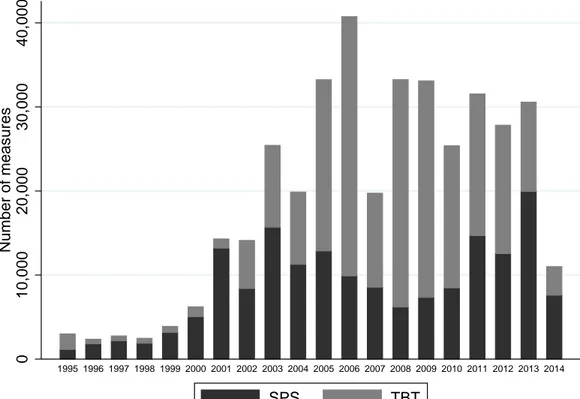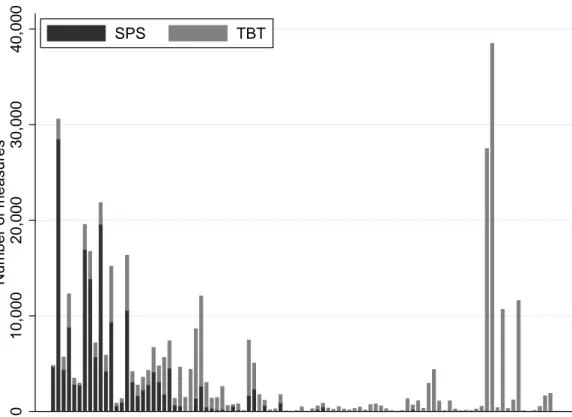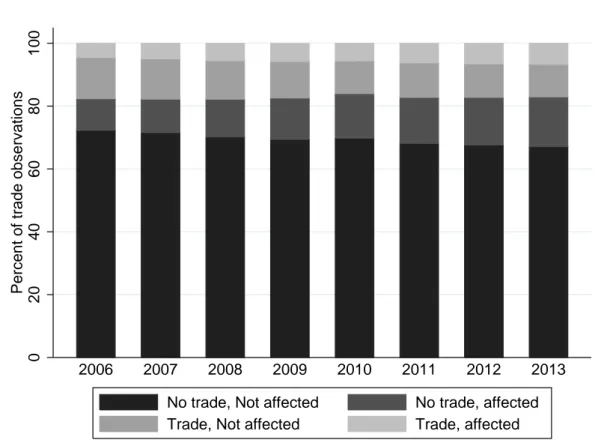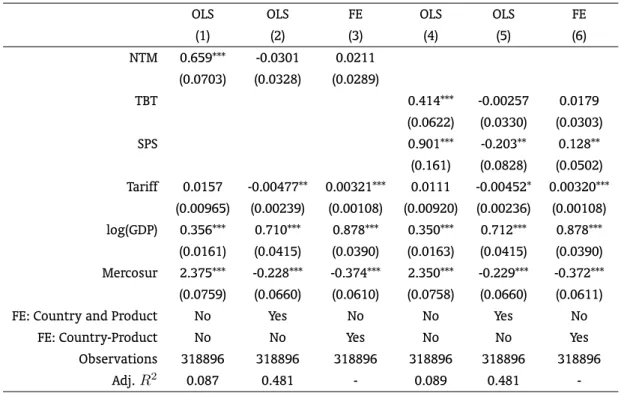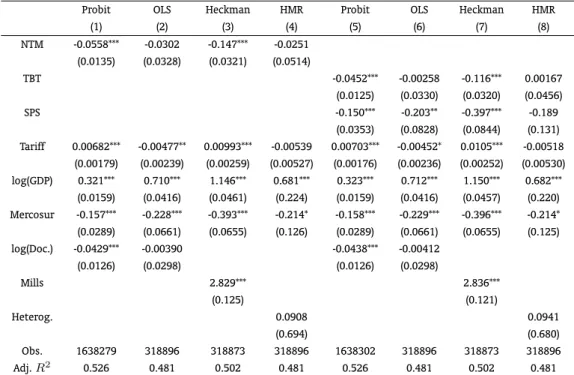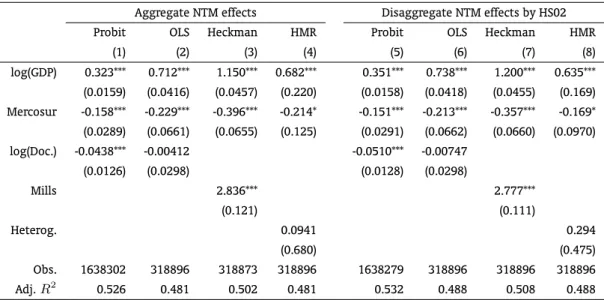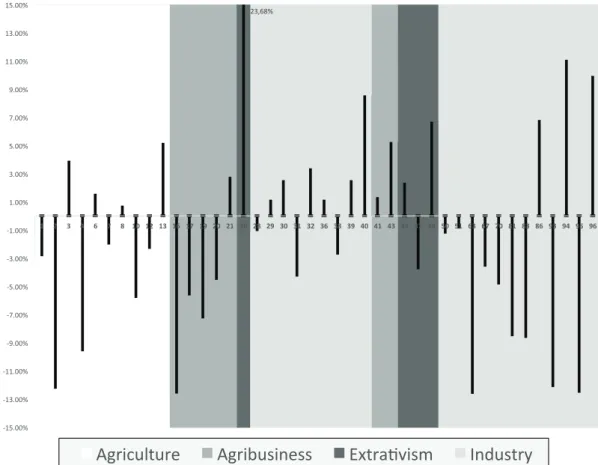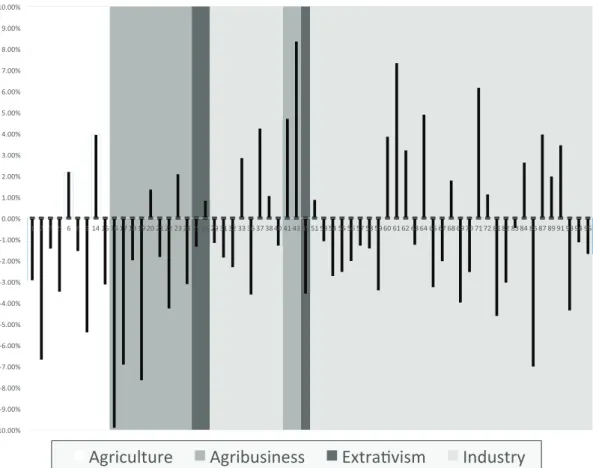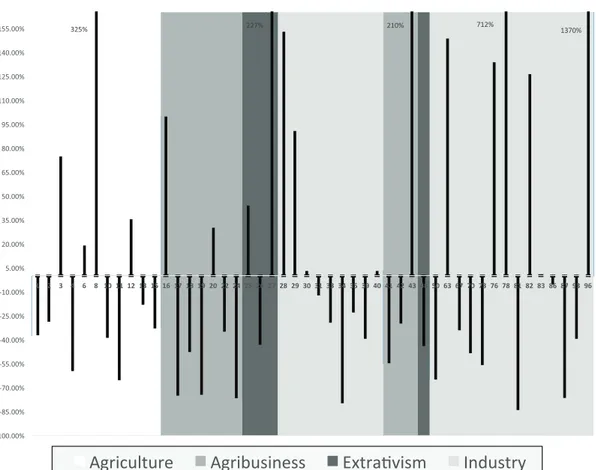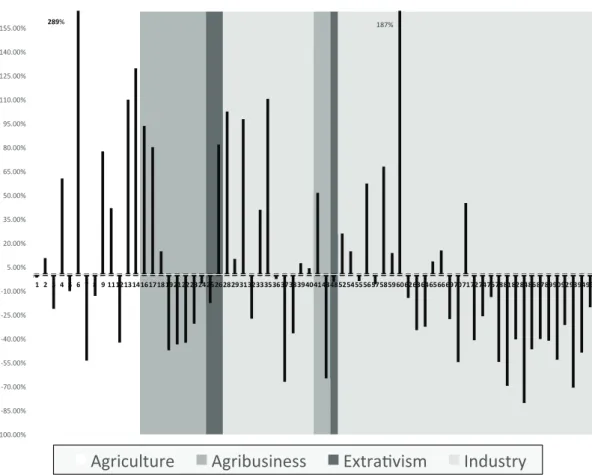On the Effects of Non-Tariff Measures
on Brazilian Exports
∗
L
UCAS
P.
DO
C. F
ERRAZ
†
M
ARCEL
R
IBEIRO
‡
P
EDRO
M
ONASTERIO
§Contents: 1. Introduction; 2. Related literature; 3. Sample and non-tariff measures
database; 4. Empirical strategy; 5. Results; 6. Final remarks.
Keywords: Non-tariff measures; SPS; TBT; Extensive margin of exports; Selection model;
Firm heterogeneity.
JEL Code: C01, F13, L13.
This article estimates the effects of TBT/SPS measures on Brazilian exports, based on the recent literature of gravity models. A Heckman selection model – theoretically grounded on the seminal Melitz model of heterogeneous firms – highlights the role played by zero trade flows as well as firm heterogeneity for estimations using gravity equations, two factors usually omitted in standard specifications. We show that both extensive and in-tensive margins of Brazilian exports are, on average, negatively affected by pre-existing TBT and SPS measures. Moreover, we contribute to the empirical literature by providing comprehensive evidence of the sectoral effects of such measures over domestic exports. We find that TBT/SPS measures - though predominantly harmful - can foster exports in several sectors of the Brazilian economy.
Este artigo estima os impactos das medidas TBT/SPS sobre as exportações brasileiras, baseado na literatura recente de modelos gravitacionais. Um modelo de seleção de Heckman é proposto – com fundamentos teóricos no modelo de firmas heterogêneas de Melitz – que destaca a relevância dos fluxos nulos de comércio, assim como da hete-rogeneidade das firmas, dois fatores usualmente omitidos em especificações conven-cionais. Nós mostramos que ambas as margens, intensiva e extensiva, das exportações brasileiras são, em média, negativamente afetadas pelas TBTs e SPSs. Ademais, con-tribuímos para a literatura empírica provendo ampla evidência no nível setorial para as exportações domésticas. Encontramos que medidas TBT/SPS, embora predominan-temente prejudiciais, podem estimular as exportações em vários setores da economia Brasileira.
1. INTRODUCTION
An important trend in trade policy in recent decades is the remarkable reduction of tariff barriers im-posed on international trade. This pattern is both a result of several trade liberalization rounds at the GATT/ WTO level and, more recently, the consequence of the sharp increase of regional trade agreements worldwide. Just over the last twenty years, more than four hundred preferential trade agreements were notified at the WTO. Over the same period, however, the multilateral trade system has also witnessed a growing number of notifications of non-tariff measures such as TBT (Technical Barriers to Trade) and SPS
∗Lucas Ferraz gratefully acknowledges financial support from INMETRO.
†Sao Paulo School of Economics – FGV. E-mail:❧✉❝❛s✳❢❡rr❛③❅❢❣✈✳❜r
‡Sao Paulo School of Economics – FGV. E-mail:♠❛r❝❡❧✳r✐❜❡✐r♦❅❢❣✈✳❜r
(Sanitary and Phytosanitary measures) being submitted by its members, with their legal underpinnings claimed to be based on both the TBT and SPS agreements formalized at the WTO’s Uruguay round.
Despite the fact that notifications of TBT and SPS measures are expected to be grounded in pre-existing international standards and scientific evidence, its widespread dissemination among WTO members raised concerns of a new wave of protectionism, now disguised under the umbrella of trade regulation on product standards and safety.
Surprisingly, there is a scarce literature on the broad effects of such regulations on international trade, specially in the case of Brazil. Based on a comprehensive data set and addressing some recent criticisms on the correct specification of gravity models, this paper seeks to fill this gap, bringing new evidence on the impacts of TBT and SPS measures on Brazilian exports. We show that the number of TBT/SPS measures potentially affecting Brazilian exports has increased substantially over the last decades. Results of our econometric analysis suggest that, on average, TBT and SPS measures negatively influence Brazilian exports at both intensive and extensive margins of trade. When extending the analysis to the sectoral level, we find that TBT and SPS measures could foster trade in some sectors. In order to reconcile these apparently conflicting results, we provide a rather intuitive discussion based on trade theory. Our estimations also suggest that information contained in zero trade flows should be take into consideration in order to avoid possible bias on the estimated coefficients, a clear drawback of the traditional OLS approach. When it comes to firm heterogeneity at the intensive margin of trade, we show that Brazilian exports are hardly influenced by this variable.
2. RELATED LITERATURE
According to the World Trade Organization (WTO), Sanitary and Phytosanitary (SPS) measures may be defined as any measures applied: (1) “to protect human or animal life from risks arising from additives, contaminants, toxins or diseasecausing organisms in their food; (2) to protect human life from plant -or animal - carried diseases; (3) to protect animal -or plant life from pests, diseases, -or disease-causing organisms; (4) to prevent or limit other damage to a country from the entry, establishment or spread of pests”. By the same token, Technical Barriers to Trade (TBT) “cover all technical regulations, voluntary standards and the procedures to ensure that these are met, from car safety to energy-saving devices, to the shape of food cartons. TBT measures can still cover topics related to human health such as pharmaceutical restrictions or the labeling of cigarettes, nutrition claims and concerns, quality and packaging regulations”.
SPS and TBT measures are generally classified as non-tariff measures (NTM) and most of the existing empirical literature about its effects over bilateral trade flows are based on standard gravity equations. Regardless of the real objectives behind the imposition of non tariff measures such as TBT and SPS by importing countries, several studies have provided evidence on their likely negative effects on trade, using rather standard OLS estimations (for a detailed review, see for example, Leamer, 1990, Otsuki et al., 2001, Moenius, 2004, Fontagné et al., 2005, Disdier et al., 2008).
both Disdier et al. (2008) and Fontagné et al. (2005) find positive as well as negative NTM effects on trade. However, while the latter differentiate between the effects of TBT and SPS measures on trade, the former treat both measures as the same, using just one dummy variable. To our knowledge, the work by Moenius (2004) is the first to evaluate the effects of all types of standards (environmental as well as technical) on trade for a rather comprehensive range of products (471 SITC industries) over a 16-year period. Using a sample of 12 OECD countries, he shows that the impact of country-specific stan-dards on trade varies substantially across products, with negative effects concentrated in agricultural exports, whereas trade promoting effects concentrated in manufacturing exports. A major drawback of Moenius’ work is the non-inclusion of bilateral tariffs in the estimated equations.
Interestingly, a relatively recent debate on the possible existence of misspecifications in standard gravity equations raised serious concerns over the credibility of many previous empirical studies using gravity models and addressing a broad set of issues in trade theory, including the effects of NTM on trade flows. In this regard, the work by Anderson and van Wincoop (2003) highlights the importance of controlling for the unobservable “multilateral resistance” terms in gravity equations, being the first article to formally address this issue, based on a theoretical model of monopolistic competition. In this regard, both Hummels (1999) and Feenstra (2015) advocate the use of directional (exporter and importer) fixed effects in cross-section estimations using gravity equations. For panel data analysis, Olivero and Yotov (2012) demonstrate that the multilateral resistance terms should be accounted for by exporter-time and importer-time fixed effects. Pointing out to another possible misspecification prob-lem in gravity regressions, the work by Silva and Tenreyro (2006) suggests that under heteroskedasticity, the parameters of log-linearized gravity equations estimated by OLS may lead to biased estimates of the true elasticities. More recently, another influential work by Helpman et al. (2008), inspired on previous work by Melitz (2003), raised the issue of firm heterogeneity and also on the correct treatment of zero trade flows in traditional gravity equations. This has prompted a new generation of empirical stud-ies, now addressing specification concerns such as the possible existence of sample selection bias and the influence of heterogeneous firms in gravity estimations. Among this new generation of empirical studies focused on the effects of NTM on trade flows are Disdier and Marette (2010), Xiong and Beghin (2012) and Crivelli and Groeschl (2016). All three studies measure the effects of product-specific regula-tions on the intensive and extensive margins of trade over a rather narrow set of products and sectors, using the Heckman selection model (Heckman, 1979). For instance, Disdier and Marette (2010) find no significant effect of maximum residue levels of pesticides (MRLs) on market entry (extensive margin) for food and agricultural products imported by OECD countries. However, they find a negative MRL effect on OECD imports of crustaceans (intensive margin). Xiong and Beghin (2012) evaluate the effect of EU aflatoxin standards on trade in groundnuts between the EU-15 and a set of 9 African countries from 1989 to 2006. They find an insignificant effect of the MRL imposed by EU on African exports of groundnuts. The more recent and comprehensive work by Crivelli and Groeschl (2016) evaluate the ef-fects of a rather specific group of SPS measures (Specific trade concerns)1on bilateral trade in food and
agricultural products involving 114 importer and 124 exporting countries over a time period of 15 years (1996-2010). They find that, on the whole, SPS measures negatively influence the extensive margin of trade (probability to export) but may foster trade at the intensive margin (current volume exported). Moreover, when they separate the SPS measures in two categories, they find that those more prone to generate extra fixed costs to exporters (concerns related to conformity assessments) negatively influ-ence the extensive margin of exporters. By the same token, those SPSs more prone to generate extra variable costs to exporters (concerns related to the characteristic of products) are the ones that foster trade at the intensive margin. Despite the fact this new generation of studies take into consideration the possible role played by zero trade flows in gravity estimations, they keep concentrated in a rather
1SPS specific trade concerns reveal particular restrictive product standards that exporters from countries raising a concern face
restricted number of sectors and NTMs. Moreover, they also ignore the potential role played by firm heterogeneity in estimations using gravity equations.
According to the work by Helpman et al. (2008) if the probability to become an exporter is cor-related to the decision on how much to export, the estimated impact of NTM on trade flows using standard gravity OLS regressions are likely to be downward biased. Regarding firm heterogeneity, the authors point out that standard gravity equations “confound the effects of trade barriers on firm-level trade with their effects on the proportion of exporting firms”. Accordingly, if firm heterogeneity is not somehow included as a explanatory variable in standard gravity equations, its absence may induce an upward bias on the estimated effects of NTM on trade flows.
The issue of sample selection bias in gravity models can be properly addressed through the Heck-man’s selection model (Heckman, 1979). In this article, we use HeckHeck-man’s model on its two-stage version. The first stage specifies a Probit model which (ceteris paribus) estimates the impact of a NTM on the probability of a firm to become an exporter. The first stage also estimates the inverse Mills ratio (the so called Heckman’s lambda) that must be added as a additional explanatory variable in the (second stage) standard gravity equation. Its noteworthy that the second stage equation estimates the impact of a NTM on bilateral trade flows, conditional on the fact that firms are already exporters.
The issue of firm heterogeneity can be also addressed in the second stage gravity equation through the fraction of exporting firms in each sector. Based on the seminal model of heterogeneous firms by Melitz (2003), Helpman et al. (2008) show that the fraction of exporting firms in each exporting sector and bilateral trade flow can be estimated based on the inverse of the cdf of the unit-normal distribution applied to the estimated first stage probabilities of a firm to become an exporter. The estimated fraction of exporting firms in each sector for each bilateral trade flow can then be added as a regressor in the second stage standard gravity equation.
The current article contributes by providing new and sound evidence on the impacts of TBT and SPS measures over Brazil’s exports, considering a rather comprehensive dataset including 4-digit level exports for all partners from 2006 to 2013. Our gravity specification incorporates recent methodological advances in the field, providing more reliable coefficient estimations. To our knowledge, this is the first work to provide evidence on the individual impacts of TBT/SPS measures on Brazilian trade for both extensive and intensive margins as well as for several exporting sectors.
The remainder of the paper is structured as follows. Section 3 provides detailed information on how the database for our panel estimations was built. Section 4 describes our empirical strategy. Section 5 shows the main results and discusses the economic intuition embedded in the reported coefficients. It also dialogs with the previous literature and discusses some policy implications and extensions derived from our results. The last section concludes.
3. SAMPLE AND NON-TARIFF MEASURES DATABASE
3.1. Sample
Brazilian exports (in current dollars) as well as import tariff data were obtained from the World Inte-grated Trade Solutions (WITS) of the World Bank. The data are annual from 2006 to 2013, according to the four-digit classification of the Harmonized System (HS04). We could have used data at the HS06 dis-aggregated level, but the notifications are defined mostly in four digits or less. Tariff data used in this work are sectoral simple averages. The advantage of using simple averages - rather than the weighted averages by trade flows - is to circumvent possible endogeneity in the estimation procedure.
can think of this procedure as representing the notion of the Most Favored Nation (MFN) clause, which is the usual treatment of tariffs in the GATT (General Agreement on Tariffs and Trade) legal framework. Strictly speaking, the MFN clause would input this importing country to replace its missing import tariff to a value equal to the minimum import tariff among countries which do not have a FTA or PTA with this particular country. Since this would change substantially the distribution of tariffs, we believed it would be more reasonable to input the mean. Most importantly, our results are robust to the exclusion of tariffs from the sample.
GDP data were obtained from the World Bank. We used GDP data in current dollars since the 4-digit export data is only available in current dollars as well. We also used sea transport costs associated with importing from the Trading Across Borders database (Doing business, World Bank). More specifically, we use the number of documents required to import as an excluded variable in our two-step Heckman selection model.
The information on non-tariff measures (TBT and SPS) applied to Brazilian exports was mostly sourced from World Trade Organization (WTO) database. It will be explained in detail in the next subsection.
Our sample consists of 179 importers (countries and territories), 1222 (HS04) products observed over eight years, from 2006 to 2013. The time span was limited by the availability of sea transport costs which starts at 2006 for most countries.
3.2. Building a database on non-tariff measures applied to Brazilian exports
WTO members must notify their non-tariff measures as required by the SPS and TBT agreements. No-tifications are multilateral, i.e., they apply to all WTO members. The noNo-tifications from 1995 to 2013 are available in the Integrated Trade Intelligence Portal (I-TIP) of WTO. Notification is a document issued by a importing country which describes the requirements imposed on its imports of several products. This includes both the product coverage of the measure and their Harmonized Classification System (HS) code. This classification may be HS02, HS04 or HS06 depending on the details of the requirements. However, only 34.6% of the existing notifications describes its HS code. To circumvent this problem we used additional information available from other sources such as the Brazilian National Institute of Metrology, Quality and Technology (Inmetro) and the Centre for WTO Studies (CWS). While Inmetro pro-vided us product codes for additional TBT notifications, the CWS propro-vided the codes for the additional SPS notifications. Data from Inmetro start in 2001. Product codes were available at the HS04 level.
We defined a non-tariff measure as a specific criteria imposed by an importing country over the exports of its trade partners with respect to a specific product. Therefore, one notification may define several measures. Thus, our measure of NTM was constructed by the following steps. First, we assigned notifications to their respective HS04 products. The following criteria was used: i) notifications with regard to HS02 codes were assigned to all of its breakdowns of HS04 codes; ii) notifications with regard to HS06 codes were discarded since the export data are in HS04 level;2iii) the notifications belonging to the European Union were assigned to their respective members taking into account the date of entry for each country.
The literature usually treats the EU as a single country when it comes to member countries notifica-tions of SPS and TBT measures. However, when working with panel data this may be misleading since the number of EU members increases over time in the sample. This is particularly important as the EU is one of the most active issuers of TBT and SPS measures as well as one of Brazil’s main trade partners.
The construction of the dummy variable for measures,N T Mijt, followed the criteria below:
N T Mijt= (
1 ift≥τij
0 ift < τij
wheretdenotes year andτij is the first year when the importing countryinotified a given TBT, SPS
or both measures on productj. SP SijtandT BTijtdummies are defined analogously but only using
TBT or SPS measures. Implicitly, its was assumed that, once notified, measures do not expire. For instance, a SPS measure issued in 2002 will not only impose restrictions in that year but over all years afterwards. In principle, countries may withdraw their notifications, but the WTO database do not provide this information. In practice, however, we believe that new measures usually impose more restrictive requirements over pre-existing ones, so that authorities do not bother to withdraw the less restrictive measures.
Figure 1: Adoption of new SPS and TBT by year
0
10,000
20,000
30,000
40,000
Number of measures
1995 1996 1997 1998 1999 2000 2001 2002 2003 2004 2005 2006 2007 2008 2009 2010 2011 2012 2013 2014
SPS TBT
Figure 1 shows the number of new measures adopted from 1995 to 2014 for all countries in the sample, from the perspective of exporting firms in Brazil. It is clear that the number of measures have increased in the 2000’s. However, it is important to point out that we had limited information on the notifications of TBT measures before 2001, as the dataset sourced from INMETRO starts at this year. When it comes to SPS measures, our dataset from CWS starts in 1995.
Notwithstanding the fact that our sample starts in 2006, we used information from NTM issued from 1995 up to 2013, as they get accumulated through time.
widespread over agricultural chapters, TBT measures tend to be concentrated in a few chapters related to manufacturing activities.3
Moreover, chapters related to agribusiness are heavily affected by both types of measures. Therefore, it is important to distinguish the effects of these types of measures on producing firms in exporting countries, since they affect different sectors as well as are likely to impose distinct requirements on imports.
Figure 2: Adoption of new SPS and TBT by product
0
10,000
20,000
30,000
40,000
Number of measures
01 02 03 04 05 06 07 08 09 10 11 12 13 14 15 16 17 18 19 20 21 22 23 24 25 26 27 28 29 30 31 32 33 34 35 36 37 38 39 40 41 42 43 44 45 46 47 48 49 50 51 52 53 54 55 56 57 58 59 60 61 62 63 64 65 66 67 68 69 70 71 72 73 74 75 76 78 79 80 81 82 83 84 85 86 87 88 89 90 91 92 93 94 95 96 97
SPS TBT
In this study, the dummy variables for TBT and SPS measures treat in a symmetric way the intrinsic potential for each of those measures to affect trade flows. Obviously, this could lead to misleading conclusions about their impacts on trade flows since their effects could be very different in terms of trade restrictiveness. To our knowledge, there is no paper in the literature that was able to classify each of these measures according to their potential to affect trade flows in a satisfactory way. The treatment of each SPS and TBT measures by their potential to affect trade flows would demand, to say the least, a very time consuming and deep technical examination of each existing measure, with quite uncertain and likely questionable results. Therefore, this issue is out of the scope of this work.
3The most affected chapter by SPS measures is 02 (Meat). For TBT, the most affected chapters are 84 (Machinery and Mechanical
4. EMPIRICAL STRATEGY
The literature quantifying the impacts of NTM on trade flows is relatively scarce and generally uses linear regression models.4 One exception, for instance, is Crivelli and Groeschl (2016) which uses the
same econometric framework as the one applied in this article but only for a limited number of sectors and for a small set of NTMs related to specific trade concerns.
Helpman et al. (2008) shows that to measure barriers to trade properly it is essential to take into account the extensive margin decision, i.e., whether or not to export. Therefore, empirical works using gravity equations should also take into consideration pre-existing zero bilateral trade flows between countries in the sample, which usually account for a large share of the observations. This point is even more pronounced in our sample since we use bilateral trade data at the HS04 level. Therefore, the probability of a particular product not being traded by a pair of countries is much larger than the probability of that pair not to trade at all. Therefore, the extensive margin is even more critical in our case.
Figure 3 shows the share of observations by year depending on whether bilateral trade flows are zero or positive as well as whether it is affected by measures or not. Some points are noteworthy. First, around 80% of the observations in the sample correspond to zero trade flows, which would be neglected in the case of simple OLS regressions. Second, over 10-15% of the zero trade flows are affected by a NTM. If the absence of trade were induced by the presence of a NTM one would underestimate the effects of the NTM on trade if not taking this into account. Finally, the NTM coverage is broad once the majority of the Brazilian exporting products are affected by at least one NTM.
Existing NTM are likely to impose higher fixed and/or variable costs for exporting firms in order to attend the required standards. This explain why a NTM is usually viewed as a trade barrier. Despite of that, there are alternative channels through which a NTM can actually induce higher exports from affected countries. For instance, it may be the case that compliance with a NTM could increase foreign demand for exporting firms, so long as importers associate complying behavior to higher quality pro-ducers. Another important channel that can lead to higher exports after a NTM is imposed is through its general equilibrium effects. Since NTM are multilateral in nature and exporting firms are heteroge-neous in productivity, the expected change in relative international production costs due to compliance with a given NTM tend to favor the most productive players in the export market.
Therefore, applied works on the effects of NTM on trade flows should not take for granted that they operate as legal barriers to trade as its is assumed, for instance, in Kee et al. (2009). As a matter of fact, our results show that there are products which are affected positively by both TBT and SPS measures as well as products which are affected negatively by them. Most importantly, NTM may also affect the extensive margin of trade, which standard linear regression gravity models, by its very nature, are not able to capture.
Therefore, we follow the specification by Helpman et al. (2008) where the extensive margin decision of a exporting firm is represented by the following Probit model (first stage equation in Heckman’s two-stage model):
ρijt≡P r(Tijt= 1|W∗) = Φ β∗N T Mijt+Zijtθ∗+α∗i +γj∗+ηt∗
(1)
whereTijtis an indicator variable which is equal to one if there are positive Brazilian exports of product
j to countryiin periodt. W∗ = N T MijtZijtα∗i γ∗j η∗t
denote the vector of all observables. The intensive margin decision is given originally by the following specification (second stage equation):
yijt =βN T Mijt+βλλˆijt+log(βzexp(ˆzijt+ ˆλijt)−1) +Xijtθ+αi+γj+ηt+εijt (2)
Figure 3: Trade and Non-tariff Measures
0
20
40
60
80
100
Percent of trade observations
2006 2007 2008 2009 2010 2011 2012 2013
No trade, Not affected No trade, affected
Trade, Not affected Trade, affected
Note:Author’s calculations based on 179 importing countries and 1222 HS04 products.
withεijt ∼ N(0,σ2)that has correlationρwith the structural error from first step. yist denote the
(FOB) value of exports of a HS04 productj from Brazil, in periodt, to destinationi. The parameters αi(α∗i),γj(γj∗)andηt(η∗t)are dummies of importers, products and years, respectively.Xijtis a vector
for a standard set of gravity control variables andZijtis the vector which includesXijtas well as the
excluding variable from the first stage equation.
The variableszˆijt = Φ−1(ˆρijt)andλˆijt ≡ λ(ˆzijt) = φ(ˆzijt)
Φ(ˆzijt) denote firm heterogeneity and the
inverse Mills ratio (non-selection hazard) which are constructed based on the extensive margin esti-mation. The inverse Mills ratio control for the extensive margin decision from the first stage equation (possible selection bias due to existing zero trade flows). Following the specification by Helpman et al. (2008) and given that our data is disaggregated at the product level, the variablezˆijt represents the
within-product Brazilian firm heterogeneity.
con-suming, requiring several days for a single simulation. Therefore, we opted for the linear specification of equation (2), replacing the term in logs (on its right-hand side) by the single variablezˆijt.5
Control variables includes importer’s GDP and applied tariffs. Since we are estimating the effects of non-tariff measures on Brazilian exports it is essential to include tariffs in the gravity equation, once NTM might be used as protectionist instruments replacing standard tariff barriers. Since Brazil is the only exporter in the sample, the importer country fixed effects controls for all time-invariant con-ventional gravity variables such as distance, common religion, language and legal origin, land border, colonial ties and so on.
For an appropriate identification of Heckman’s second stage equation, we selected variables to be excluded from the second stage equation (where they must have no explanatory power) but to be included in the first stage. In this regard, Helpman et al. (2008) use information on the regulation costs of firm entry at the country pair level. More specifically, they build a country pair index on the number of documents and time required to start a business. This article uses regulation costs that are trade-specific and so we believe this must be a more appropriate instrument. Therefore, the number of documents required to import a standardized cargo by sea at the destination country was selected as the excluded variable in the first stage.6This information was sourced from the Trading Across Borders
database (Doing Business, World Bank).
Even though we controlled for product fixed effects, there are roughly two reasons for the effects of NTM to be different across sectors. First, Brazilian sectors differs in terms of competitiveness. Sec-ond, a NTM can specify very different requirements depending on the sector it applies. Therefore, in order to capture sector-specific effects of NTM on trade flows, a extended gravity specification was built where the dummy variables forSP SijtandT BTijtmeasures were allowed to interact with sectorial
dummies. Since there were 1222 sectors at the HS04 level in the original sample, we took a more par-simonious approach and introduced a new set of sectorial dummy variables at the 2-digit classification level covering 96 chapters. In the final specification, therefore, we added182(= 96×2)more regressors into the model, instead of 2444 as it would be the case if we decided to stick to the original specification. Last, the HS02 specific coefficients can capture variation over its HS04 sub-sectors which would not be possible with HS04 specific coefficients instead. Hence, we believe this final extended specification may allow more reliable estimates when it comes to sector-specific effects of NTM on trade.
5. RESULTS
Table 1 reports the estimated NTM effects on Brazilian exports applying rather traditional econometric approaches with gravity equations, for the aggregated version of the gravity model (when the sector-level effects of NTM are not taken into consideration). The idea is to show how misleading traditional approaches may be, when some of the issues raised in the recent literature on gravity models are ignored. While columns 1, 2 and 3 reports the effects of NTM (TBT or SPS) on Brazilian exports, columns 4, 5 and 6 split the NTM dummy variable into two distinct dummies: one to capture the effects of TBT measures and another one to capture the effects of SPS measures. As shown in column 1 for a pooled OLS regression, when no fixed effects are taken into consideration, the impacts of NTM on trade flows are positive and statistically significant at 1%. When both country-specific and product-specific fixed effects are added to the model (column 2), it turns out that the estimated coefficient on the NTM dummy variable becomes negative and statistically not different from zero. Column 3 shows the results now
5This same linear version of equation (2) is also tested in Helpman et al. (2008) showing outstanding robustness. In order to
avoid collinearity, the variableszˆijt= Φ−1(ˆρijt)andλˆijt≡λ(ˆzijt) = φ(ˆ
zijt)
Φ(ˆzijt)will be tested separately.
6Since Helpman et al. (2008) had limited information on country pair regulatory costs, they decided to work with “religion” as
using a fixed panel specification where the estimated coefficient on the NTM dummy variable becomes positive but remains statistically not different from zero. When the NTM dummy variable is split into TBT and SPS dummies, the results are qualitatively similar, exception made to the coefficient on the SPS measure, that now becomes statistically different from zero through columns 4-6.
Results like the ones reported in Table 1 should be viewed with caution. As will be seen in Table 2, if either the probability to become and exporter is somehow correlated with the decision on how much to export or if the proportion of exporting firms varies substantially throughout Brazilian sectors, the coefficients reported in Table 1 are likely to be biased (see Helpman et al., 2008). Standard OLS approaches like the ones reported in Table 2 were widely used – with some small variations – in the previous empirical literature on the NTM effects on trade, such as in the works of Otsuki et al. (2001), Moenius (2004), Fontagné et al. (2005), Disdier et al. (2008).
Table 1: Aggregate effect of NTMs on Brazilian exports: OLS and Fixed effects
OLS OLS FE OLS OLS FE
(1) (2) (3) (4) (5) (6)
NTM 0.659*** -0.0301 0.0211
(0.0703) (0.0328) (0.0289)
TBT 0.414*** -0.00257 0.0179
(0.0622) (0.0330) (0.0303)
SPS 0.901*** -0.203** 0.128**
(0.161) (0.0828) (0.0502) Tariff 0.0157 -0.00477** 0.00321*** 0.0111 -0.00452* 0.00320***
(0.00965) (0.00239) (0.00108) (0.00920) (0.00236) (0.00108)
log(GDP) 0.356*** 0.710*** 0.878*** 0.350*** 0.712*** 0.878***
(0.0161) (0.0415) (0.0390) (0.0163) (0.0415) (0.0390)
Mercosur 2.375*** -0.228*** -0.374*** 2.350*** -0.229*** -0.372***
(0.0759) (0.0660) (0.0610) (0.0758) (0.0660) (0.0611)
FE: Country and Product No Yes No No Yes No
FE: Country-Product No No Yes No No Yes
Observations 318896 318896 318896 318896 318896 318896
Adj.R2 0.087 0.481 - 0.089 0.481
-Note:Product cluster-robust standard errors in parenthesis. All regressions includes time fixed effects.
The results for the two-stage Heckman selection model are shown in Table 2. Similarly to Table 1, the first columns in the table (columns 1-4) show the results for the effects of NTM on Brazilian exports, while the last columns (columns 5-8) show the results for the individual effects of both TBT and SPS measures.
Table 2: Aggregate effect of NTMs on Brazilian exports: Heckman and HMR(2008)
Probit OLS Heckman HMR Probit OLS Heckman HMR
(1) (2) (3) (4) (5) (6) (7) (8)
NTM -0.0558*** -0.0302 -0.147*** -0.0251
(0.0135) (0.0328) (0.0321) (0.0514)
TBT -0.0452*** -0.00258 -0.116*** 0.00167
(0.0125) (0.0330) (0.0320) (0.0456)
SPS -0.150*** -0.203** -0.397*** -0.189
(0.0353) (0.0828) (0.0844) (0.131)
Tariff 0.00682*** -0.00477** 0.00993*** -0.00539 0.00703*** -0.00452* 0.0105*** -0.00518
(0.00179) (0.00239) (0.00259) (0.00527) (0.00176) (0.00236) (0.00252) (0.00530)
log(GDP) 0.321*** 0.710*** 1.146*** 0.681*** 0.323*** 0.712*** 1.150*** 0.682***
(0.0159) (0.0416) (0.0461) (0.224) (0.0159) (0.0416) (0.0457) (0.220)
Mercosur -0.157*** -0.228*** -0.393*** -0.214* -0.158*** -0.229*** -0.396*** -0.214*
(0.0289) (0.0661) (0.0655) (0.126) (0.0289) (0.0661) (0.0655) (0.125)
log(Doc.) -0.0429*** -0.00390 -0.0438*** -0.00412
(0.0126) (0.0298) (0.0126) (0.0298)
Mills 2.829*** 2.836***
(0.125) (0.121)
Heterog. 0.0908 0.0941
(0.694) (0.680)
Obs. 1638279 318896 318873 318896 1638302 318896 318873 318896
Adj.R2 0.526 0.481 0.502 0.481 0.526 0.481 0.502 0.481
Note:Product cluster-robust standard errors in parenthesis. All regressions includes country, product and time fixed effects.
A qualitative assessment of the results reported in the first and second columns of Table 2 suggest that most of the variables that help to explain the extensive margin decision of Brazilian exporters (Probit estimation) also explain their intensive margin decisions (pooled OLS). The resulting correlation between residuals from the two equations highlights the importance of zero trade flows to be taken into account in gravity estimations, as it points out to the existence of sample selection bias. As a matter of fact, when the Mills ratio estimated in the first-stage is added to the second stage equations (columns 3 and 7) the results clearly suggest that ignoring sample selection bias in traditional gravity models (columns 2 and 6) may lead to a significant underestimation of the effects of NTM on trade flows (downward bias). When it comes to the effects of sector-specific firm heterogeneity on Brazilian exports, results in columns 4 and 8 suggest that they are not statistically different from zero. However, controlling for sector-specific firm heterogeneity does not seem to alter significantly the coefficients from traditional gravity estimations using OLS (columns 2 and 6), even though it tends to slightly understate their effects on trade flows, as predicted by Helpman et al. (2008).
Results in Table 2 provide evidence that controlling for sample selection bias is relatively more important than controlling for firm heterogeneity when it comes to explaining the impacts of NTM on Brazilian exports. This result is apparently at odds with Helpman et al. (2008) predictions about the relative magnitude of these two effects, suggesting that the higher relevance of firm heterogeneity in explaining trade flows, as obtained by them using country-level bilateral trade flows, may be dependent on the existing level of aggregation in the database. Arguably, the more disaggregated the database, the higher the incidence of zero trade flows and the lower the variation in the proportion of exporting firms at the sectoral level, as it seems to be the case in our study.
at both intensive and extensive margins of trade. Therefore, it is likely that the TBT/SPS measures imposed against Brazilian exports imply both substantial fixed (affecting the extensive margin) and variable costs (affecting the intensive margin) for exporting firms in Brazil. Moreover, ignoring the possibility of sample selection bias brought about by the presence of zero trade flows in the dataset may lead to substantial underestimation of NTM effects on trade flows, as suggested by Helpman et al. (2008). This discussion will be resumed in subsection 5.1, when we evaluate sectoral results.
Table 3 reports the results for the extended model, when 96 (HS02) sector dummy variables are allowed to interact with both TBT and SPS dummy variables, resulting in 192 additional regressors. Results in columns 1 to 4 are the same as the ones reported in columns 5 to 7 of Table 2 for the group of controls and are represented again for the sake of comparison. As can be seen from columns 5 to 8 in Table 3, extending the model to capture the sector-level impacts of TBT and SPS measures slightly im-proves the fit without significantly changing the coefficients for the group of control variables, attesting the robustness of our results.
Table 3: Disaggregate effect vs aggregate specification
Aggregate NTM effects Disaggregate NTM effects by HS02 Probit OLS Heckman HMR Probit OLS Heckman HMR
(1) (2) (3) (4) (5) (6) (7) (8)
log(GDP) 0.323*** 0.712*** 1.150*** 0.682*** 0.351*** 0.738*** 1.200*** 0.635*** (0.0159) (0.0416) (0.0457) (0.220) (0.0158) (0.0418) (0.0455) (0.169) Mercosur -0.158*** -0.229*** -0.396*** -0.214* -0.151*** -0.213*** -0.357*** -0.169* (0.0289) (0.0661) (0.0655) (0.125) (0.0291) (0.0662) (0.0660) (0.0970) log(Doc.) -0.0438*** -0.00412 -0.0510*** -0.00747
(0.0126) (0.0298) (0.0128) (0.0298)
Mills 2.836*** 2.777***
(0.121) (0.111)
Heterog. 0.0941 0.294
(0.680) (0.475)
Obs. 1638302 318896 318873 318896 1638279 318896 318896 318896 Adj.R2 0.526 0.481 0.502 0.481 0.532 0.488 0.508 0.488
Note:Product cluster-robust standard errors in parenthesis. All regressions includes country, product and time fixed effects.
It is important to notice that the estimated coefficients from the two-stage Heckman selection model do not coincide with the marginal effects. For instance, since our results suggest that firm heterogeneity does not play a role in explaining Brazilian sectoral exports, the marginal effects for the second stage equation can be calculated as:7
me=β+βλλ(β∗N T Mijt+Zijtθ∗+α∗i +γj∗+ηt∗)−λ(Zijtθ∗+α∗i +γ∗j +ηt∗)
(3)
where, formally,me=E[yijt|W∗,N T Mijt= 1]−E[yijt|W∗,N T Mijt= 0].
5.1. Sectoral results, extensions and policy implications
Results from the two-stage Heckman selection model shown in Table 2 suggested that, on average, a NTM works as a trade barrier for both extensive and intensive margins of Brazilian exports. Therefore,
TBT/SPS measures negatively affect the trade performance of both potential and current exporters in the country. As new production requirements are imposed to exporting firms, higher production costs are an obvious channel through which a NTM may affect exporters.
However, a sectoral level analysis on the effects of NTM over Brazilian exports reveals that its effects on trade are not unambiguously negative, as previously assumed in empirical works such as, for exam-ple, Kee et al. (2009). Figures 4 and 5 show the sectoral level marginal effects of SPS and TBT measures on the extensive margin of Brazil’s exports, respectively. These marginal effects stem from the first-stage equation of the Heckman selection model (equation 1), where the TBT and SPS dummy variables are allowed to interact with sectoral dummies at the two-digit level of the harmonized system (Table 3). As for the intensive margin of Brazil’s exports, Figures 6 and 7 show the sectoral level marginal ef-fects of SPS and TBT measures, respectively, stemming from the second-stage equation of the Heckman selection model (linearized version of equation 2), computed by equation 3. In both cases, extending the analysis to the sectoral level shows that, though harmful on average, TBT and SPS measures can foster trade in some sectors of the domestic economy, a result already detected in previous empirical studies (see, for instance, Fontagné et al., 2005, Disdier et al., 2008).
Figure 4: Marginal effect of SPS on sectoral Brazilian exports: Probit
!"#$%&'
()*+,,&' ()"+,,&' ())+,,&' (-+,,&' (.+,,&' (*+,,&' ("+,,&' ()+,,&' )+,,&' "+,,&' *+,,&' .+,,&' -+,,&' ))+,,&' )"+,,&' )*+,,&'
!" #" $" %" &" '" (" !)" !#" !$" !&" !'" !*" #)" #!" #&" #(" #*" $)" $!" $#" $&" $(" $*" %)" %!" %$" %%" %'" %(" +)" +!" &$" &'" ')" (!" ($" (&" *$" *%" *+" *&"
/0123456417'
/0128492:799'
;<61=>?29@'
A:B4961C'
Note:Marginal effects of products that have statistically significant coefficients at 5%.
Figure 5: Marginal effect of TBT on sectoral Brazilian exports: Probit
!"#$##%& !'$##%& !($##%& !)$##%& !*$##%& !+$##%& !,$##%& !-$##%& !.$##%& !"$##%& #$##%& "$##%& .$##%& -$##%& ,$##%& +$##%& *$##%& )$##%& ($##%& '$##%& "#$##%&
"& .& -& +& *& (& '& ",&"+&"*&")&"(&"'&.#&."&..&.-&.,&.+&.*&.'&-"&-.&--&-*&-)&-(&,#&,"&,-&,+&+"&+-&+,&++&+*&+)&+(&+'&*#&*"&*.&*-&*,&*+&*)&*(&*'&)#&)"&).&("&(.&(-&(,&(*&()&('&'"&'-&',&'+&
/0123456417&
/0128492:799&
;<61=>?29@&
A:B4961C&
Note:Marginal effects of products that have statistically significant coefficients at 5%.
a whole, as results in Table 2 have suggested. In order to reconcile this apparently conflicting results, it is important to keep in mind that a NTM may potentially affect exports through, at least, four main channels, according to standard trade theory. First, as it imposes more strict requirements on produc-tion process by firms, it may lead to higher marginal costs to export. Second, more strict requirements on production may entail new investments in technology and equipments by firms, increasing fixed costs to export. Third, compliance with a NTM may positively affect consumer preferences in importing countries, shifting import demand and consequently bursting exports. Fourth, more efficient exporters tend to be more resilient to increasing costs of production then less efficient ones. Therefore, higher production costs are expected to be relatively more harmful to the exports of less efficient suppliers. In this case, depending on the magnitude of relative effects, more efficient suppliers may be better off with the imposition of a NTM. A more sophisticated theoretical framework representing the four channels described above can be found in the seminal work by Melitz (2003), where both extensive and intensive margins of trade are integrated in a monopolistic competition model (Krugman, 1980) with heterogeneous firms.
Figure 6: Marginal effect of SPS on sectoral Brazilian exports: Heckman
!"#$% ""($% "&'$% (&"$% &!('$%
)&''*''$% )+#*''$% )('*''$% )##*''$% ),'*''$% )"#*''$% )&'*''$% #*''$% "'*''$% !#*''$% #'*''$% -#*''$% +'*''$% .#*''$% &&'*''$% &"#*''$% &,'*''$% &##*''$%
!" #" $" %"&" '" !(" !!" !#" !$" !)" !&" !*" !'" !+" #(" ##" #%" #)" #&" #*" #'" #+" $(" $!" $$" $%" $)" $+" %(" %!" %#" %$" %'" )(" &$" &*" *(" *$" *&" *'" '!" '#" '$" '&" '*" +$" +&"
/0123456417%
/0128492:799%
;<61=>?29@%
A:B4961C%
Note:Marginal effects of products that have statistically significant coefficients at 5%.
Sectoral level results for the extensive margin decision, represented in Figures 4 and 5, suggest that both SPS and TBT measures can negatively affect the probability of a Brazilian firm to become an exporter through the imposition of unaffordable fixed costs. This sectoral information has relevant implications for exporting promoting policies in the country, particularly the ones devoted to stimulate the participation of SMEs (Small and Medium sized Enterprises) in the international market. Taking into account the sector specific additional costs demanded for compliance with existing TBT and SPS measures in importing countries may significantly undermine the expected benefits of those policies.
When it comes to the intensive margin decisions, Figures 6 and 7 show that, though predominantly negative, existing TBT and SPS measures can again contribute to burst exports in several sectors of the Brazilian economy. Comparing their effects across sectors, however, while the negative effects of SPS measures tend to be evenly distributed among sectors in Brazil, the negative effects of TBT measures tend to be relatively more concentrated in capital intensive sectors. Given the well known lack of comparative advantages of manufacturing exports in Brazil, this result is hardly unexpected.
From the two-stage Heckman selection model used in this work it is straightforward to estimate the ad valorem equivalents8of TBT and SPS measures for any sectoral bilateral trade flows, based on their
Figure 7: Marginal effect of TBT on sectoral Brazilian exports: Heckman
!"#!" #$%!"
&#''(''!" &$)(''!" &%'(''!" &))(''!" &*'(''!" &+)(''!" &#'(''!" )(''!" +'(''!" ,)(''!" )'(''!" -)(''!" $'(''!" .)(''!" ##'(''!" #+)(''!" #*'(''!" #))(''!"
$% !% &% '% (% )% *% "% #% $$%$!%$&%$'%$)%$*%$"%$#%!$%!!%!&%!'%!(%!)%!"%!#%&$%&!%&&%&(%&)%&*%&"%&#%'+%'$%'&%'"%(!%('%((%()%(*%("%(#%)+%)!%)&%)'%)(%))%)#%*+%*$%*!%*'%*)%*"%"$%"!%"'%")%"*%"#%#+%#!%#&%#'%#(%
/0123456417"
/0128492:799"
;<61=>?29@"
A:B4961C"
Note:Marginal effects of products that have statistically significant coefficients at 5%.
It is noteworthy that the ad valorem equivalents estimated by the two-stage Heckman selection model are compatible with CGE models that do not incorporate the extensive margin decision, which are still predominant in the empirical literature. Therefore, in those models the ad valorem equivalents of TBTs and SPSs must represent estimations of pure extra variable costs and shall not be influenced by any kind of fixed costs. This is the case as the marginal effect from equation (3) is conditional on the decision of entry. This must be true since fixed costs must only influence entrepreneur’s decision to become an exporter (Heckman’s first stage equation representing the effects of NTM on the extensive margin of trade) but not his decision on how much to export, given that he is already an exporter (Heckman’s second stage equation representing the effects of NTM on the intensive margin of trade). Again, this reasoning is fully backed by the theoretical foundations found in Melitz’ seminal model of heterogeneous firms.
The common view of TBT and SPS measures as real barriers to trade should not lead one to under-estimate the potential social benefits they might provide. Unlike tariffs, the optimal policy for TBT/SPS measures will often not be their full elimination but rather their rationalization to the social utility maximizing level, a point already made in Fugazza and Maur (2008). In this regard, it seems advisable that Brazilian trade authorities concentrate more efforts on the formalization of regulatory agreements with Brazil’s main trade partners, in order to minimize the cost-benefit ratio of existing regulations and, whenever possible, to avoid duplication costs and unnecessary red tape.
6. FINAL REMARKS
The number of TBT and SPS notifications at the WTO has grown significantly over the last decades, following the explosion of preferential trade agreements and the decline in global import tariffs. While recognized as legal instruments devoted to protect the welfare of importing countries, its widespread use has raised suspicions of a new wave of protectionism among WTO’s members.
This paper provides sounding and comprehensive empirical evidence of the effects of TBT/SPS mea-sures over Brazilian exports, detailed at the 2-digit level of the harmonized system, when most of previous works in the literature have focused on particular sectors and specific measures. While not formally addressing the potential opportunistic use of NTM against Brazilian exports, this paper has shown that TBT and SPS measures can indeed work as significant trade barriers for exporting firms in Brazil, depending on the sector where they are applied. In more extreme sector-level cases, existing SPS and TBT measures can substantially limit the export potential of Brazilian firms, as the magnitudes of their estimated Probit effects have suggested.
This paper has also touched upon another set of relevant issues on the impacts of NTM on trade flows. Starting with a new econometric specification based on the previous work by Helpman et al. (2008), it has shown how previous gravity approaches on the effects of NTM over trade flows might be misleading. Moreover, we discussed the main channels through which a NTM may affect trade flows, based on the insights from the Melitz model, in order to better clarify the net effects of NTM on both the extensive and intensive margins decisions of exporting firms. Accordingly, the determination of both direction and magnitude of the effects of TBT/SPS measures on trade flows will depend crucially on the interaction of key supply and demand factors operating in exporting and importing countries, respectively, being essentially an empirical issue.
BIBLIOGRAPHY
Anderson, J. E. & van Wincoop, E. (2003). Gravity with Gravitas: A Solution to the Border Puzzle. American Economic Review, 93(1):170–192.
Andriamananjara, S., Dean, J., Feinberg, R., Ferrantino, M. J., Ludema, R., & Tsigas, M. E. (2004). The Effects of Non-Tariff Measures on Prices, Trade, and Welfare: CGE Implementation of Policy-Based Price Comparisons. Technical Report 15863.
Andriamananjara, S., Ferrantino, M. J., & Tsigas, M. E. (2003). Alternative Approaches in Estimating the Economic Effects of Non-Tariff Measures: Results from Newly Quantified Measures. Technical Report 15872.
Baldwin, R. E., McLaren, J., & Panagariya, A. (2000). Regulatory Protectionism, Developing Nations, and a Two-Tier World Trade System. Brookings Trade Forum, pages 237–293.
Crivelli, P. & Groeschl, J. (2016). The Impact of Sanitary and Phytosanitary Measures on Market Entry and Trade Flows.The World Economy, 39(3):444–473.
Disdier, A.-C., Fontagné, L., & Mimouni, M. (2008). The Impact of Regulations on Agricultural Trade: Evidence from the SPS and TBT Agreements.American Journal of Agricultural Economics, 90(2):336–350.
Disdier, A.-C. & Marette, S. (2010). The combination of gravity and welfare approaches for evaluating nontariff measures.American Journal of Agricultural Economics, 92(3):713–726.
Feenstra, R. C. (2015).Advanced international trade: theory and evidence. Princeton University Press.
Fontagné, L., Mimouni, M., & Pasteels, J.-M. (2005). Estimating the Impact of Environmental SPS and TBT on International Trade. Integration and Trade Journal, 22:7–37.
Francois, J., Van Meijl, H., & Van Tongeren, F. (2005). Trade liberalization in the Doha Development Round.Economic Policy, 20(42):350–391.
Fugazza, M. & Maur, J.-C. (2008). Non-Tariff Barriers in Computable General Equilibrium Modelling. Technical Report 38.
Harrison, W. J. & Pearson, K. R. (1994). Multiregional and Intertemporal AGE Modelling via GEMPACK. Technical report.
Heckman, J. J. (1979). Sample selection bias as a specification error. Econometrica: Journal of the Econometric Society, pages 153–161.
Helpman, E., Melitz, M., & Rubinstein, Y. (2008). Estimating Trade Flows: Trading Partners and Trading Volumes. The Quarterly Journal of Economics, 123(2):441–487.
Hummels, D. (1999). Toward a Geography of Trade Cost.GTAP Working Papers.
Kee, H. L., Nicita, A., & Olarreaga, M. (2009). Estimating Trade Restrictiveness Indices. The Economic Journal, 119(534):172–199.
Krugman, P. (1980). Scale economies, product differentiation, and the pattern of trade. The American Economic Review, 70(5):950–959.
Leamer, E. E. (1990). Latin America as a target of trade barriers erected by the major developed countries in 1983. Journal of Development Economics, 32(2):337–368.
Moenius, J. (2004). Information versus product adaptation: The role of standards in trade. Technical report, Working Paper, International Business & Markets Research Center.
Olivero, M. & Yotov, Y. (2012). Dynamic gravity: Theory and empirical implications. Canadian Journal of Economics, 45(1):64–92.
Otsuki, T., Wilson, J. S., & Sewadeh, M. (2001). What price precaution? European harmonisation of aflatoxin regulations and African groundnut exports. European Review of Agricultural Economics, 28(3):263–284.
Silva, J. S. & Tenreyro, S. (2006). The log of gravity. The Review of Economics and Statistics, 88(4):641–658.
Xiong, B. & Beghin, J. (2012). Does European aflatoxin regulation hurt groundnut exporters from Africa? European Review of Agricultural Economics, 39(4):589–609.
